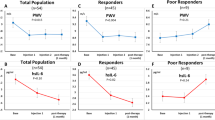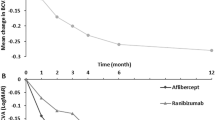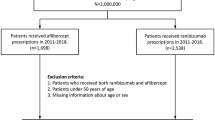Abstract
Purpose
To investigate whether intravitreal ranibizumab injections administered to a child alter systemic plasma levels of total and free VEGF 165.
Methods
A 9-year-old child sustained a choroidal rupture from blunt trauma. He subsequently developed a secondary choroidal neovascular membrane, which was treated with five ranibizumab injections over a period of 8 months. Peripheral venous blood samples were taken at each visit over a period of 12 months and plasma was extracted. Plasma VEGF 165 levels were determined using enzyme-linked immunosorbent assay and were assayed both pre- and post-immunodepletion to remove complexed VEGF.
Results
Plasma VEGF 165 levels proved labile following intravitreal injection of ranibizumab. Levels increased by 30% above baseline following the first intravitreal ranibizumab injection, but then returned to baseline despite two subsequent injections. There was then a rebound increase of 67% in total plasma VEGF levels following a further injection, which remained above baseline for 12 weeks despite two further intravitreal ranibizumab injections. Baseline levels were re-attained 26 weeks after the final injection.
Conclusions
These results suggest intravitreal ranibizumab injections can cause significant, multiphasic changes in systemic VEGF levels. This may be of particular clinical significance in children as VEGF is known to be vital in the development of major organs, in addition to its role in the maintenance of normal organ function in adults.
Similar content being viewed by others
Log in or create a free account to read this content
Gain free access to this article, as well as selected content from this journal and more on nature.com
or
References
Avery RL . What is the evidence for systemic effects of intravitreal anti-VEGF agents, and should we be concerned? Br J Ophthalmol 2013; 98: i7–10.
Zhu XY, Chade AR, Rodriguez-Porcel M, Bentley MD, Ritman EL, Lerman A et al. Cortical microvascular remodeling in the stenotic kidney: role of increased oxidative stress. Arterioscler Thromb Vasc Biol 2004; 24: 1854–1859.
Haigh JJ . Role of VEGF in organogenesis. Organogenesis 2008; 4: 247–256.
Iliescu R, Fernandez SR, Kelsen S, Maric C, Chade AR . Role of renal microcirculation in experimental renovascular disease. Nephrol Dial Transplant 2010; 25: 1079–1087.
Chade AR, Kelsen S . Reversal of renal dysfunction by targeted administration of VEGF into the stenotic kidney: a novel potential therapeutic approach. Am J Physiol Renal Physiol 2012; 302: F1342–F1350.
Carneiro AM, Costa R, Falcão MS, Barthelmes D, Mendonça LS, Fonseca SL et al. Vascular endothelial growth factor plasma levels before and after treatment of neovascular age-related macular degeneration with bevacizumab or ranibizumab. Acta Ophthalmol 2012; 90: e25–e30.
Zehetner C, Kirchmair R, Huber S . Plasma levels of vascular endothelial growth factor before and after intravitreal injection of bevacizumab, ranibizumab and pegaptanib in patients with age-related macular degeneration, and in patients with diabetic macular oedema. Br J Ophthalmol 2013; 97: 454–459.
Chakravarthy U, Harding SP, Rogers CA, Downes SM, Lotery AJ et al. Ranibizumab versus bevacizumab to treat neovascular age-related macular degeneration: one-year findings from the IVAN randomized trial. Ophthalmology 2012; 119: 1399–1411.
Harding SP . IVAN Outcomes [abstract]. Invest Ophthalmol Vis Sci 2013; 54: ARVO E-Abstract.
Zarbin M, Szirth B . Current treatment of age-related macular degeneration. Optom Vis Sci 2007; 84: 559–572.
Gaudreault J, Fei D, Rusit J, Suboc P, Shiu V . Preclinical pharmacokinetics of ranibizumab (rhuFabV2) after a single intravitreal administration. Invest Ophthalmol Vis Sci 2005; 46: 726–733.
Stefanini MO, Wu FT, Mac Gabhann F . Popel AS. Increase of plasma VEGF after intravenous administration of bevacizumab is predicted by a pharmacokinetic model. Cancer Res 2010; 70: 9886–9894.
Gordon MS, Margolin K, Talpaz M, Sledge Jr GW, Holmgren E, Benjamin R et al. Phase I safety and pharmacokinetic study of recombinant human anti-vascular endothelial growth factor in patients with advanced cancer. J Clin Oncol 2001; 19: 843–850.
Yang JC . Bevacizumab for patients with metastatic renal cancer: an update. Clin Cancer Res 2004; 10: 6367S–6370S.
Willett CG, Boucher Y, Duda DG, di Tomaso E, Munn LL, Tong RT et al. Surrogate markers for antiangiogenic therapy and dose- limiting toxicities for bevacizumab with radiation and chemotherapy: continued experience of a phase I trial in rectal cancer patients. J Clin Oncol 2005; 23: 8136–8139 [PubMed: 16258121].
Segerstrom L, Fuchs D, Backman U, Holmquist K, Christofferson R, Azarbayjani F . The anti- VEGF antibody bevacizumab potently reduces the growth rate of high-risk neuroblastoma xenografts. Pediatr Res 2006; 60: 576–581 [PubMed: 16988184].
Avery RL, Pieramici DJ, Rabena MD, Castellarin AA, Nasir MA, Giust MJ . Intravitreal bevacizumab (Avastin) for neovascular age-related macular degeneration. Ophthalmology 2006; 113: 363–372.
Zimmermann R, Koenig J, Zingsem J, Weisbach V, Strasser E, Ringwald J et al. Effect of specimen anticoagulation on the measurement of circulating platelet-derived growth factors. Clin Chem 2005; 51: 2365–2368.
Loupakis F, Falcone A, Masi G, Floravanti A, Kerbel RS, Del Tacca M et al. Vascular endothelial growth factor levels in immunodepleted plasma of cancer patients as a possible pharmacodynamic marker for bevacizumab activity. J Clin Oncol 2007; 25: 1816–1818.
Bocci G, Man S, Green SK, Francia G, Ebos JML, du Manoir JM et al. Increased plasma vascular endothelial growth factor (VEGF) as a surrogate marker for optimal therapeutic dosing of VEGF receptor-2 monoclonal antibodies. Cancer Res 2004; 64: 6616–6625.
Cortez Rafael T, Ramirez Gema, Collet Lucienne, Pranjal Thakuria G, Giuliari Paolo . Intravitreous bevacizumab injection: an experimental study in New Zealand white rabbits. Arch Ophthalmol 2010; 128: 884–887.
Chiarelli F, Spagnoli A, Basciani F, Tumini S, Mezzetti A, Cipollone F et al. Vascular endothelial growth factor (VEGF) in children, adolescents and young adults with Type 1 diabetes mellitus: relation to glycaemic control and microvascular complications. Diabet Med 2000; 17: 650–656.
Comparison of Age-related Macular Degeneration Treatments Trials (CATT) Research Group1 Martin DF, Maguire MG, Fine SL, Ying GS, Jaffe GJ, Grunwald JE et al. Ranibizumab and bevacizumab for treatment of neovascular age-related macular degeneration: two-year results. Ophthalmology 2012; 119: 1388–1398.
Eremina V, Jefferson A, Kowalewska J, Hochster H, Haas M, Weisstuch J et al. VEGF Inhibition and Renal Thrombotic Microangiopathy. N Engl J Med 2008; 358: 1129–1136.
Yang KS, Lim JH, Kim TW, Kim MY, Kim Y, Chung S et al. Vascular endothelial growth factor-receptor 1 inhibition aggravates diabetic nephropathy through eNOS signaling pathway in db/db mice. PLoS One 2014; 9: e94540.
Marshall SM, Alberti KG . Comparison of the prevalence and associated features of abnormal albumin excretion in insulin-dependent and non-insulin-dependent diabetes. Q J Med 1989; 70: 61–67.
Lovestam-Adrian M, Agardh E, Agardh CD . The temporal development of retinopathy and nephropathy in type 1 diabetes mellitus during 15 years diabetes duration? Diabetes Res Clin Pract 1999; 45: 15–23.
Klein R, Zinman B, Gardiner R, Suissa S, Donnelly SM, Sinaiko AR et al. The relationship of diabetic retinopathy to preclinical diabetic glomerulopathy lesions in type 1 diabetic patients: the renin-angiotensin System Study. Diabetes 2005; 54: 527–533.
Rani PK, Raman R, Gupta A, Pal SS, Kulothungan V, Sharma T . Albuminuria and diabetic retinopathy in type 2 diabetes mellitus: Sankara Nethralaya Diabetic Retinopathy Epidemiology And Molecular Genetic Study (SN-DREAMS, report 12). Diabetol Metab Syndr 2011; 3: 9.
Molitch ME, Steffes MW, Cleary PA, Nathan DM . Baseline analysis of renal function in the Diabetes Control and Complications Trial. The Diabetes Control and Complications Trial Research Group [corrected]. Kidney Int 1993; 43: 668–674.
NICE technology appraisal guidance 274. Ranibizumab for treating diabetic macular oedema (rapid review of technology appraisal guidance 237) 2013.
Hsei V, Deguzman GG, Nixon A, Gaudreault J . Complexation of VEGF with bevacizumab decreases VEGF clearance in rats. Pharm Res 2002; 19: 1753–1756.
Motzer RJ, Michaelson MD, Redman BG et al. Activity of SU11248, a multitargeted inhibitor of vascular endothelial growth factor receptor and platelet-derived growth factor receptor, in patients with metastatic renal cell carcinoma. J Clin Oncol 2006; 24: 16–24.
Author information
Authors and Affiliations
Corresponding author
Ethics declarations
Competing interests
SRJT is supported by the UK National Institute of Health Research. SRJT has received advisory board fees from Novartis AG. ST-R receives funding from BBSRC and GlaxoSmithKline. FWKT receives funding from Baxter.
Rights and permissions
About this article
Cite this article
Shao, E., Sivagnanavel, V., Dabbagh, A. et al. Multiphasic changes in systemic VEGF following intravitreal injections of ranibizumab in a child. Eye 29, 569–573 (2015). https://doi.org/10.1038/eye.2014.343
Received:
Accepted:
Published:
Issue date:
DOI: https://doi.org/10.1038/eye.2014.343



